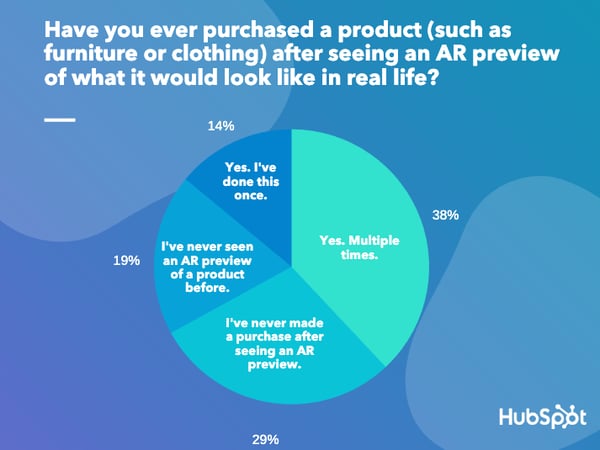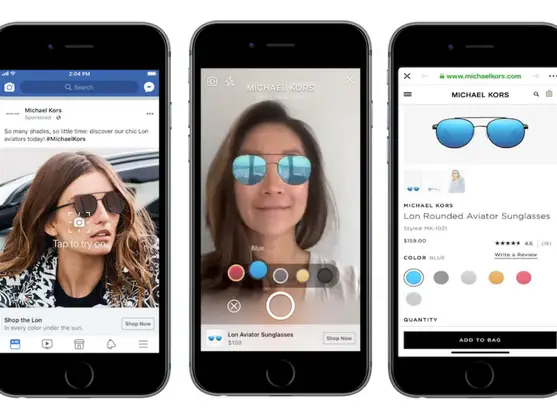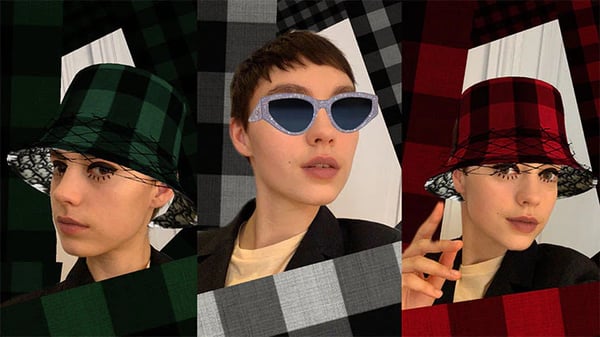According to a recent Retail Dive survey, 55% of consumers still prefer to shop in stores because they like to see or test out products before they buy them.
But, if consumers could see or try products virtually from home, would they still need to go to the store before making a purchase?
This question has been asked by companies like Amazon, Warby Parker, and IKEA which have embraced AR product reviews. With these previews, ecommerce visitors can see an item of clothing on a photo of their body, preview what furniture will look like in their bedroom, and even size themselves to ensure they're buying a product with the best fit.
But is this virtual experience really as effective as a traditional store or fitting room at getting people to buy?
Skeptics might say no. With AR being costly to implement and product viewings only requiring a physical store location, many marketers think that this technology isn't worth the fuss.
However, as the world grows more and more digital, each new generation is making even more online purchases. They're also embracing technologies like AR/VR for entertainment or retail purposes.
Not to mention, while holidays like Black Friday cause a burst in foot-traffic, retail businesses are finding it more challenging to keep people coming into stores throughout the rest of the year.
While AR might have been inaccessible to retail marketers in the past, could it be a revenue-generating opportunity at some point in the near future?
To determine if augmented reality was actually a beneficial marketing technology, I asked 300 consumers about their experiences with AR product previews using Lucid survey software.
In the survey, consumers were asked, "Have you ever purchased a product (such as furniture or clothing) after seeing an augmented-reality preview of what it would look like in real life?"
Since the technology is still rather new, you might expect consumers to say they've never used an AR product preview. However, you might also be wondering if those who've used an AR product preview actually converted.
If you think that the general population hasn't used this new retail technology, you might be surprised by the result below.

Data Source: Lucid
According to the survey, 52% of consumers have purchased at least one item after seeing an AR preview of how it would look in real life. Over 30% of that group have purchased multiple products after previewing them with AR.
So, what does this mean for small or medium-sized retailers?
Understandably, you might not be able to afford AR technology to highlight your products just yet. However, the fact that more brands are using this feature to influence purchasing decisions means that technology and personalized digital marketing tactics like AR previews will likely become more prominent.
Just because you can't afford AR now, doesn't mean you'll be unable to leverage it in the future. As augmented reality grows more prominent and more valuable to businesses, AR ecommerce tools might become more accessible or competitively priced. This is a theme we've seen with the influence of artificial intelligence.
While the technology was pricey and inaccessible to small-to-medium businesses at first, there are now a number of affordable out-of-the-box tools that marketers and businesses can leverage.
Even if you can't take advantage of the latest marketing technology today, it's still important to keep up with how other retailers are using it -- especially if they're selling products in a similar category as you.
Below, I'll walk you through a few AR strategies that effectively benefit retailers now, or could be a vital product marketing tactic in the future:
3 AR Product Marketing Strategies to Watch in 2020
Mobile Previews on Ecommerce Sites
With this strategy, a mobile ecommerce website visitor can find a product they're interested in, open a camera when tapping an AR preview button, and then view how the product -- such as furniture -- will look in the room they're in. Some ecommerce platforms also allow prospects to see what an accessory such as glasses, will look on their face. If a customer likes what they see in an AR preview, they can exit the preview and make a purchase without setting foot in a store.
With increasing mobile ecommerce, this strategy allows visitors to discover a product through mobile search or an app, visit an ecommerce site, get an idea of what it looks like in real life, and then smoothly purchase it wherever they are. It also eliminates key friction points that could halt a purchase such as going to the store or not finding a product in the right size or color in a physical retail location.
At the moment, we're already seeing corporations like IKEA, Home Depot, and Amazon embrace AR product previews on mobile sites and apps. But, this strategy might not be totally inaccessible to smaller businesses.
For example, a small bicycle retailer called PureCycles wanted to improve its website's mobile experience and conversions. With a large catalog of bicycle product shots taken from multiple angles, they created AR previews with Shopify.
PureCycles says its use of virtual previews improved the customer experience on mobile-optimized browsers and allowed customers to answer key questions about their products, such as "Will this bicycle fit in my small apartment?"
Virtual Mirrors
Ever seen a shirt you loved in a clothing store but couldn't find it in your size? Or, have you ever wanted to test out expensive makeup before buying it? These are two business cases that could call for AR mirrors, often called "virtual" or "magic" mirrors.
With AR mirror technology, you can stand in front of a screen in selfie mode, and see an overlay of how products in the store's catalog will look on you in the right size or shade.
After your virtual experience, some virtual mirrors will allow you to order the product or send yourself a link for it so you can order it later. This prevents any additional friction related to having to wait until the item comes back in stock.
This virtual process also allows you to see products that the store sells but might not sell in the store due to seasonality or space-related limitations.
This strategy is used by Charlotte Tilbury, a UK-based beauty retailer.
Virtual mirrors, purchased and installed by Holition, line the boutique's walls. When a customer looks into one, the camera and software scan the measurements and skin tone of their face. From there, the customer taps different makeup items on the screen to see how the products will look on their face. Here's a quick video demonstration of how the software works:
Social Media Filters
Have you ever launched Instagram or Facebook Stories and noticed new AR filters that allowed you to test out products directly through your app? If not, you'll definitely see more of this soon.
Recognizing the low-hanging fruit of AR previews in ecommerce, Facebook and Instagram, are actively taking steps to provide more commerce that leverage this technology. For example, in late 2019, Facebook made AR filter ads available in Facebook Ads. These ads allow users to test out products in Facebook Stories and its News Feed.
Here's an example of what one of these ads might look like:

Leveraging product-centric AR filters on social media provides the perks of the mobile AR previews without relying on shoppers to actually visit an ecommerce site.
As social media users tap through their friend's Stories or content, they might notice a Story with an AR product in it or discover and AR preview that they can experience. These types of experiences are much more natural than seeing an influencer posting about a dress or makeup item, visiting the ecommerce site, and then doing added research to see if it's the right shade.
While social AR previews are still in early phases, platforms like Facebook are already identifying types of retailers that could thrive with these tools. For example, AR features that allow users to preview products via social media could be a game-changer in the world of fashion and beauty. In 2018, this industry already saw a 164% social media revenue increase from paid promotions.
With social media users actively engaging with paid beauty ads, brands that are able to leverage AR on Facebook and Instagram would be able to reach social-media-friendly audiences on popular platforms and allow them to try new products.
One company that's already leveraging AR to highlight products on social media is Dior, which allows users to try looks from its Fall/Winter fashion line on their Instagram Stories camera.

As social media and mobile surfing continue to dominate how millennials and Gen Z spend their time, the need to invest in clever mobile advertising, such as AR ads, will also grow. .Although the combination of AR tactics and social media is still new -- and not worth blowing your budget on just yet -- you should still continue to follow brands and competitors that leverage it in case this technology becomes more accessible in the future.
What AR Success Means for Retailers
While the growth of AR shows how businesses are using new technology to benefit the customer journey, the effectiveness of AR and other retail technologies shows that customers are increasingly looking for digital, personalized, and frictionless shopping experiences.
And this makes sense. More and more, people are using mobile ecommerce stores and online social platforms to find, vet, and ultimately purchase products.
Even if you do have a physical store, you'll need to embrace highly digital tactics to ensure that you're gaining brand awareness from people online along with people in your neighborhood.
And while you shouldn't spend all of your money investing in AR, there are other tactics you can take on to inform your audience about your products or services. These include highlighting your products on social media, launching a small but scalable ecommerce store, or sending customers personalized emails about products they might like based on what they've already purchased from your store.
No comments:
Post a Comment